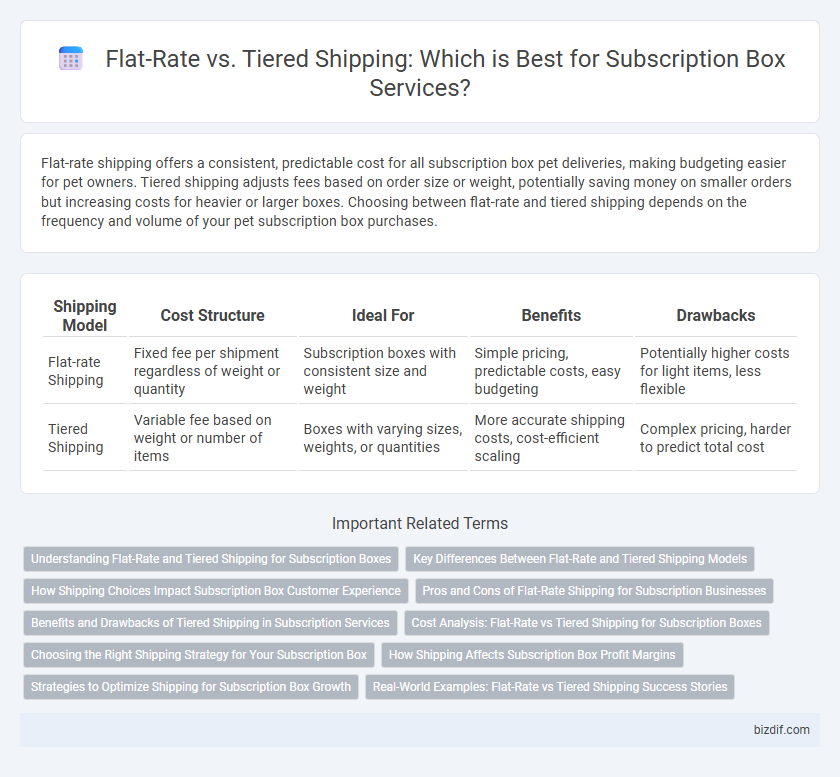Flat-rate shipping offers a consistent, predictable cost for all subscription box pet deliveries, making budgeting easier for pet owners. Tiered shipping adjusts fees based on order size or weight, potentially saving money on smaller orders but increasing costs for heavier or larger boxes. Choosing between flat-rate and tiered shipping depends on the frequency and volume of your pet subscription box purchases.
Table of Comparison
| Shipping Model | Cost Structure | Ideal For | Benefits | Drawbacks |
|---|---|---|---|---|
| Flat-rate Shipping | Fixed fee per shipment regardless of weight or quantity | Subscription boxes with consistent size and weight | Simple pricing, predictable costs, easy budgeting | Potentially higher costs for light items, less flexible |
| Tiered Shipping | Variable fee based on weight or number of items | Boxes with varying sizes, weights, or quantities | More accurate shipping costs, cost-efficient scaling | Complex pricing, harder to predict total cost |
Understanding Flat-Rate and Tiered Shipping for Subscription Boxes
Flat-rate shipping charges a fixed fee regardless of the number of items or package weight, providing predictable costs for subscription box businesses and customers. Tiered shipping adjusts fees based on order size or weight, allowing companies to align shipping costs more closely with actual expenses. Choosing between flat-rate and tiered shipping impacts customer satisfaction, cost management, and operational efficiency in subscription box services.
Key Differences Between Flat-Rate and Tiered Shipping Models
Flat-rate shipping charges a single, consistent fee for all orders regardless of size or weight, providing transparency and simplicity for subscription box customers. Tiered shipping models apply different fees based on predefined order thresholds or weight categories, offering flexibility and potential cost savings for varying box sizes. The key difference lies in predictability versus adaptability, with flat-rate ensuring fixed costs and tiered shipping optimizing fees based on shipment specifics.
How Shipping Choices Impact Subscription Box Customer Experience
Flat-rate shipping simplifies cost expectations for subscription box customers, fostering trust and reducing cart abandonment by providing a consistent fee regardless of order size. Tiered shipping offers flexibility and may encourage larger purchases by scaling fees based on order weight or value, but can lead to confusion or dissatisfaction if costs increase unexpectedly. Shipping choices directly influence customer perception of value, convenience, and transparency, impacting overall satisfaction and loyalty in subscription box services.
Pros and Cons of Flat-Rate Shipping for Subscription Businesses
Flat-rate shipping offers subscription businesses predictable and straightforward pricing, simplifying budgeting for both the company and customers while enhancing customer satisfaction through transparent costs. However, this model may reduce profitability when shipping bulky or heavy items as the flat fee remains constant regardless of package size or distance, potentially leading to higher expenses for the seller. Choosing flat-rate shipping improves operational efficiency and appeals to customers valuing cost certainty but requires careful cost analysis to avoid margin erosion.
Benefits and Drawbacks of Tiered Shipping in Subscription Services
Tiered shipping in subscription services offers flexibility by charging customers based on order size or weight, encouraging larger purchases and reducing costs for lower-volume orders. This model can increase customer satisfaction through perceived fairness but may also introduce complexity and uncertainty in shipping fees, potentially deterring subscribers. Businesses benefit from aligning shipping costs with order characteristics, yet must balance administrative overhead and clear communication to prevent confusion.
Cost Analysis: Flat-Rate vs Tiered Shipping for Subscription Boxes
Flat-rate shipping offers consistent, predictable costs that simplify budgeting for subscription box businesses, often benefiting companies with uniform package weights and dimensions. Tiered shipping pricing adjusts based on order weight or size brackets, potentially reducing expenses for lighter shipments but introducing variability that complicates forecasting. Analyzing subscription box fulfillment data reveals that flat-rate shipping minimizes unexpected shipping cost fluctuations, while tiered shipping can enhance profitability if average parcel weights align closely with lower-tier thresholds.
Choosing the Right Shipping Strategy for Your Subscription Box
Flat-rate shipping offers predictable costs for both businesses and subscribers, simplifying budgeting and enhancing customer satisfaction by providing a consistent fee regardless of order size. Tiered shipping adjusts fees based on order weight or value, optimizing profitability by aligning shipping costs with the actual expense, which can benefit subscription boxes with varying package sizes. Selecting the right shipping strategy depends on order consistency, customer preferences, and cost management goals to balance affordability and operational efficiency.
How Shipping Affects Subscription Box Profit Margins
Flat-rate shipping simplifies cost prediction by charging a single fee regardless of weight, helping subscription boxes maintain steady profit margins. Tiered shipping adjusts fees based on package size or distance, potentially increasing profitability for varying product types but adding complexity to cost management. Accurate shipping cost calculation directly impacts customer satisfaction and retention, crucial factors for sustaining subscription box revenue streams.
Strategies to Optimize Shipping for Subscription Box Growth
Flat-rate shipping offers predictable costs and simplifies pricing, encouraging customer retention by eliminating surprise fees, while tiered shipping enables cost savings on heavier or bulkier subscription boxes through variable rates based on weight or order size. Implementing data-driven strategies such as analyzing average box weight and customer location aids in choosing the most efficient model, reducing shipping expenses and enhancing customer satisfaction. Leveraging carrier partnerships and negotiating volume discounts further optimizes fulfillment costs, directly supporting scalable growth for subscription box businesses.
Real-World Examples: Flat-Rate vs Tiered Shipping Success Stories
Dollar Shave Club's flat-rate shipping model simplifies costs for subscribers, driving customer loyalty through predictable expenses and streamlined fulfillment. Birchbox employs tiered shipping fees based on order size, boosting average order value by encouraging larger purchases to qualify for reduced or free shipping. These contrasting approaches highlight how flat-rate shipping fosters simplicity and retention, while tiered shipping strategies incentivize higher spending and optimize revenue growth.
Flat-rate shipping vs Tiered shipping Infographic

 bizdif.com
bizdif.com